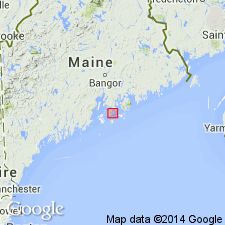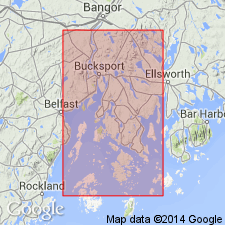
- Usage in publication:
-
- Stonington Granite
- Modifications:
-
- Named
- Geochronologic dating
- Dominant lithology:
-
- Granite
- AAPG geologic province:
-
- New England province
Summary:
Named the Stonington Granite in coastal south-central Maine, eastern Penobscot Bay. Consists of massive, light-red granite with rapakivi texture. Rock dated by Rb-Sr (whole rock) as 341+\-21 Ma or Mississippian. Unit is younger than the Oak Point Granite.
Source: GNU records (USGS DDS-6; Reston GNULEX).

- Usage in publication:
-
- Stonington Granite*
- Modifications:
-
- Overview
- Geochronologic dating
- AAPG geologic province:
-
- New England province
Summary:
Stonington Granite in northern Penobscot Bay, ME, consists of light pinkish gray, massive coarse- to medium-grained biotite granite with irregular aggregates of gray quartz and porphyritic anhedral to subhedral microcline phenocrysts, some mantled by oligoclase (rapakivi texture). Oval patches of granitic pegmatite, less than 0.5 m in diameter, are common. Unit intrudes Oak Point Granite. Mississippian age is based on Rb-Sr whole-rock age of 334+/-21 Ma (recalculated age of Brookins and Spooner, 1970).
Source: GNU records (USGS DDS-6; Reston GNULEX).
For more information, please contact Nancy Stamm, Geologic Names Committee Secretary.
Asterisk (*) indicates published by U.S. Geological Survey authors.
"No current usage" (†) implies that a name has been abandoned or has fallen into disuse. Former usage and, if known, replacement name given in parentheses ( ).
Slash (/) indicates name conflicts with nomenclatural guidelines (CSN, 1933; ACSN, 1961, 1970; NACSN, 1983, 2005, 2021). May be explained within brackets ([ ]).

